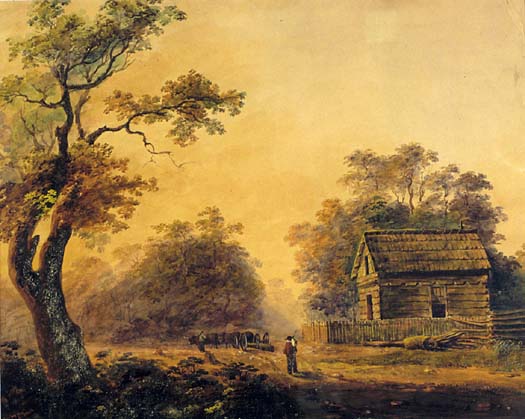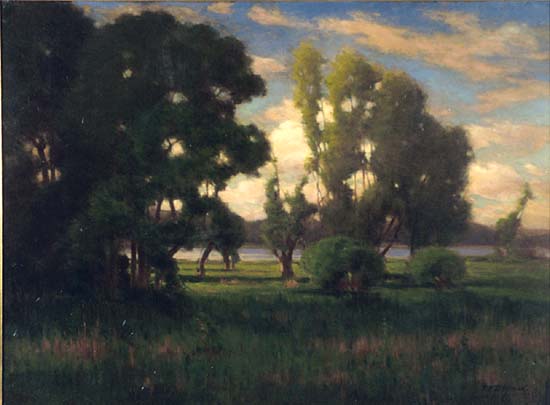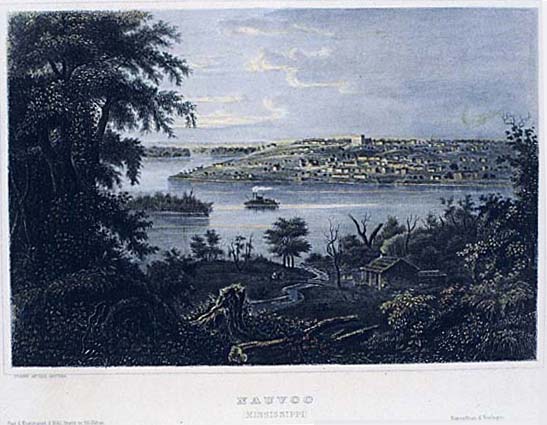Beautiful or Sublime?
Perceptions and Preconceptions of Landscape in the Early Nineteenth Century
Consciously or subconsciously, people see landscapes through their cultural eyes. They often try to compare new landscapes with ones they know, or if they are familiar with landscapes in painting and literature, they compare their feelings with the poetic styles they have read or seen. Sometimes the previous experience of see stylized painted landscapes influences how people perceive real landscapes.
Meriwether Lewis was educated in the natural sciences while preparing for the journey in Philadelphia. He studied with Charles Wilson Peale, who headed his own museum and painted pictures. Lewis was familiar with poetry and painting, and the prevailing philosophies toward the landscape — the Beautiful and the Sublime. The beautiful landscapes were those quiet, softly-colored scenes of lakes, fields, forests, and domestic grounds seen in English paintings and found in the landscapes of the eastern United States. The sublime landscape was a romanticized one in which craggy mountains, high waterfalls, and wide open spaces were featured. The western frontier of America was certainly full of examples of sublime landscape.
In addition to painting, other arts, such as poetry, prose, and music, featured "Beautiful and Sublime" characteristics. Lewis wanted the prose in his journals to reflect how uplifted he felt about the geographical features he was seeing, but he was not a poet.
The Journal
When Lewis saw the Great Falls of the Missouri River on June 13, 1805, he
was unhappy with his own attempts to describe them in his journal. He was
searching for phrases that would communicate the majesty and impact of the
sight and sound of the falls. At one point he almost ripped up his pages in
frustration at his lack of poetic skills. Why did it matter to him? His next
statement gives us the reason:
“I wished for the pencil of Salvator Rosa [EC: a Titian] or the pen of Thomson, that I might be enabled to give to the enlightened world some just idea of this truly magnificent and sublimely grand object, which has from the commencement of time been concealed from the view of civilized man.”
The next day they went upstream and he saw a second set of falls:
“I now thought that if a skillful painter had been asked to make a beautiful cascade that he would most probably have presented the precise image of this one; nor could I for some time determine on which of those two great cataracts to bestow the palm, … at length I determined between these two rivals for glory that this was pleasingly beautiful, while the other was sublimely grand.”
— p. 285-290, (Gary E. Moulton, ed.(1987). The Journals of the Lewis and Clark Expedition, vol. 4. Univ. of Nebraska Press)
Wilderness
Another psychological and cultural element visible here was the attitude of
Europeans and early Americans that the wilderness was a dangerous place until
it was tamed by settlement. Lewis was not as typical in this regard when he
described terrain. He saw the plains as fertile with grass and flowers, not
barren just because trees were not growing there. In 1702 an earlier traveler,
Pierre Delliette, saw a similar prospect of a tamed wilderness:
“Here you begin to see the beauty of this country, both for the soil, which yields bountifully, and for the abundance of animals. On one side [of the Illinois River] you see prairies requiring only to be turned up by the plow, and on the other side valleys spreading half a league before reaching the hills, covered with walnuts and oaks; and behind these, prairies like those I have just spoken of.”
What is “beautiful”?
Examples of “beautiful” landscapes in art were those painted by
Claude Lorrain (1600-1682) and Nicholas Poussin (1594-1665). These landscape
paintings have a small color range and glowing lighting effects. The subjects
were staged classical scenes and architecture. Their work influenced later
painters such as John Constable (1776-1837), J.M.W. Turner (1775-1851), and
in the United States (1825-1875), painters of the Hudson River School. Their
work evokes the positive aspects of the classical utopia of Arcadia.
https://www.kfki.hu/~arthp/html/c/claude/
Web Gallery of Art has images of many paintings by Claude Lorrain.
Early explorers from Europe described the beauty of Illinois in their journals:
“Our Illinois [Indians] inhabit a very pleasant country…the great rivers which water it, the vast and dense forests, the delightful prairies, the hills covered with very thick woods, — all these features make a charming variety.”
— Gabriel Marest, 1712
What is “sublime”?
The poet that Clark wished to emulate, James Thomson (1700-1748), was a Scot.
He was famous for his four poems "The Seasons", written in the 1720s.
What he is remembered for today are the words for the hymn Rule Britannia.
Here is an excerpt from "The Seasons: Summer" (lines 432-436)
“Tis raging noon; and, vertical, the sun
Darts on the head direct his forceful rays.
O'er heaven and earth, far as the ranging eye
Can sweep, a dazzling deluge reigns; and all,
From pole to pole, is undistinguish'd blaze.”
https://eir.library.utoronto.ca/rpo/display/poem2210.html
Read the
entire poem.
It was this feeling of the sublime that led Francis Scott Key (1780-1843)
to write "The Star-Spangled Banner" to the tune of "Anacreon
in Heaven" when he saw the British bombard Baltimore in 1814.
The painter that Lewis wished to emulate, Salvator Rosa (1615 – 1673), was an Italian painter. Rosa started a literary society and briefly participated in an amateur drama group. Many of his paintings had classical themes similar to those painted by Claude Lorrain. However, the mood of their stories was as much in the wild ruggedness of the rocks, trees, and sky as in the figures of the composition. When Lewis saw the larger than life falls and rugged precipices in the area of modern-day Montana, he wanted to describe them in terms that were poetic following the literary and artistic style used to depict beauty and sublimity in his era.
Following in the footsteps of Lewis and Clark, European and American artists found the “sublime” landscapes and painted them in a romantic manner. These landscapes had craggy mountains instead of rounded ones. The waterfalls were high, the trees were tall, and the land appeared untouched by humans. The height of the American sublime stylecame 50 years after Lewis and Clark. George Catlin (1796-1872), German painter Alfred Bierstadt (1830-1902), Karl Bodmer (1809-1893), and Thomas Moran (1837-1902) painted sublime interpretations of the land they saw. The images they created informed Americans’ imaginations about their country, even through the twentieth century.
Norton
Anthology of English Literature: Romantic Period
https://www.wwnorton.com/nael/romantic/topic_1/beauties.htm
The “beautiful” aesthetic in Illinois
Lewis and Clark did not “wax sublime” about the landscape of Illinois.
Illinois terrain certainly did not fit Lewis’ image of the sublime.
However, many Illinois locations have been the inspiration for Illinois artists
to paint the “beautiful.” Descriptions of the beauty of the landscape
occur in the journals of Jolliet and other French explorers of Illinois, and
naturalists such as John James Audubon.
“Though the trees were entirely stripped of their verdure, I could not help raising my eyes toward the tops, and admiring their grandeur. The large sycamores with white bark formed a lively contrast with the canes beneath them; and the thousands of parroquets, that came to roost in the howwlow trunks at night, were to be objects of interest and curiosity.”
— John James Audubon, 1810
Here are several examples from the collection of the Illinois State Museum.
They are early interpretations of the landscape painted in the “beautiful”
aesthetic that Meriwether Lewis mentioned in his own interpretation of the
landscape.
This O'Brien oil on canvas has the glowing sky and delicate, dark trees of the Lorraine tradition of painting. The scene is idyllic and serene.
This painting also shows the influence of Claude Lorraine and Jean Baptiste-Camille Corot (1796-1875). The artist Frank Peyraud (1858-1948) was born in Switzerland and moved to Chicago in 1881.
This engraving features a classical composition, framed by trees on the left, of a calm evening on the Mississippi River at Nauvoo, Illinois.


